
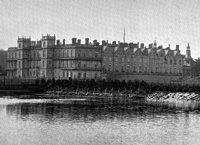
Welbeck Abbey
Newcastle & Portland Genealogy Chart
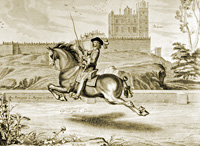
1st Duke of Newcastle at Bolsover Castle
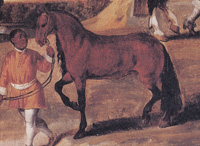
Machomilia, a Turk
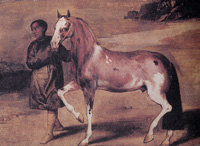
Paragon, a Barb
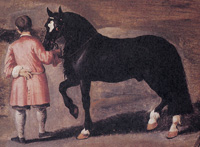
Rubecan, a Russian or Polish horse
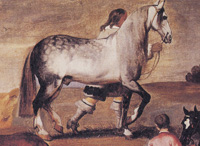
Nobillissimo, a Neapolitan Courser
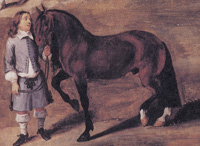
Le Superbe, a Spanish horse
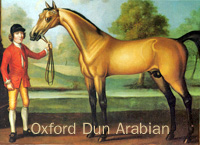
Oxford Dun Arabian
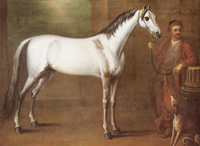
Bloody Shouldered Arabian
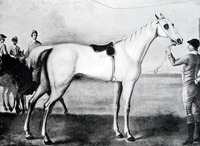
Brisk, by Bloody Shouldered Arabian
William Cavendish (1593-1676), 1st Duke of Newcastle upon Tyne
William was created Earl of Newcastle in 1628, Marquess of Newcastle upon Tyne in 1643 and Duke of Newcastle upon Tyne in 1665. He married Elizabeth Bassett around 1618 and their son Henry Cavendish (1630-1691), 2nd Duke of Newcastle upon Tyne, had a daughter, Margaret (1661-1716), who married John Holles (1662-1711), 4th Earl of Clare, who was created Duke of Newcastle in 1694. He met his second wife in France and they married in 1645 although this union did not produce any heirs. A royalist who left England following the defeat of the King's army at Marston Moor, Newcastle attained lasting fame during his tenure in Rotterdam where he established a riding school which cultivated the art of haute-école or high-school dressage riding and published his first work on horsemanship titled La Méthode et Invention Nouvelle de Dresser les Chevaux (1657-58). Whilst in Holland he also acquired eight barbary horses in which he was reputed to take great delight. All of them appear in one or more paintings by Abraham van Diepenbeke including the Turk named Machomilia and the brightly coloured Barb named Paragon. Prior to his exile the Duke had established a large stud and as Mr Prior points out the inventories of the royal stud at Tutbury indicate that several stallions were acquired from the Duke and that given the "well-known predilection of the Duke for them, it may be assumed that they were all three Barbs" [Royal Studs:55]. It is not known how much of this original stock was retained at Welbeck or other of the family seats or if this stock was the foundation for the new stud he established on his return to England. The Duke was well known for his preference for Barbs and Spanish horses and presumably focused on these types.
John Holles (1662-1711), 4th Earl of Clare, 1st Duke of Newcastle upon Tyne
Margaret, the granddaughter of William Cavendish (mentioned above), married the Earl of Clare in 1690 and he was created Duke of Newcastle upon Tyne in 1694. Along with her fortune Margaret brought the family seat of Welbeck to her marriage and the stud continued under their stewardship. It is from the Newcastle papers published by Mr Prior in Early Records of the Thoroughbred Horse that we learn of the introduction of the "bred horse" into the Welbeck stud during this Duke's tenure. Three of these were mares from James Darcy, two were mares from Mr Viner and another was a mare, apparently valued far above the others and a gift from William Jessop (son-in-law of James Darcy), from whom Miss Slamerkin (b f 1729 Young True Blue) and most of Family 7 descend.
Mr Prior makes the observation that "The acquisition of horses from Aleppo, from whence came the highest bred Arabians, seems to have always been an undertaking of great difficulty, quite apart from any question of price. It is of interest to note that it was from here that the Darley Arabian came in 1704, Lord Oxford's Dun Arabian in 1715, and the Bloody Shouldered Arabian in 1719-20. Lord Oxford also imported two Arabian horses from Turkey for his stud at Welbeck in 1711. The Pagett Arabian, extensively used at Welbeck, was sent by (William, sixth) Lord Pagett to the Duke of Newcastle in April, 1703..." [Royal Studs:81], however he does not mention the names of these two Arabian horses from Turkey and there is no indication of any importations or purchases in the Newcastle inventory for 1711, and since the Duke died that year it could be supposed that none would be expected. If the date of 1711 is correct then perhaps Mr Prior meant to say "Wigmore" (seat of the Harley family) rather than "Welbeck". There is evidence which indicates that both the Oxford Dun Arabian and the Bloody Shouldered Arabian spent at least some of their time at Welbeck although both may have covered primarily at Wimpole (seat of the Cavendish family).
In an account of mares to be served in the year 1711 the note appears that the Layton Grey Mare is to be covered by the Great Paget Arabian however Mr Prior observes that the "Harley Arab, or Chestnut" is appended and suggests that the mare was likely covered by both stallions [Early Records:118]. Since neither the Great Paget Arabian nor the Little Harley Arabian was chestnut (both produced bays from chestnut mares) the identity of this chestnut stallion is not revealed. Other stallions mentioned in the Newcastle papers include Lord Dorchester's Turk ("ye Spanish horse"), Mr Pulleine's Arabian, Lord Stamford's Barb and Lord Chesterfield's White Barb although it is not clear whether these stallions were on the premises or just the covering stallion for mares who subsequently foaled at Welbeck. In any case the Layton Grey Mare duly produced a filly in 1712 "gott by ye Little Arab" [Early Records:122].
The Oxford Bloody Shouldered Arabian has a relatively well documented history which indicates that he was imported from Aleppo by Nathaniel Harley in 1720 and remained with the Harley family until 1729 when he was sent to the Duke of Somerset at Petworth. In 1713 Edward Harley (1689-1741), 2nd Earl of Oxford and Earl Mortimer, married Lady Henrietta Cavendish Holles, only daughter of John Holles (1662-1711), 1st Duke of Newcastle upon Tyne. Lady Henrietta brought Welbeck Abbey in Nottinghamshire and Wimpole Hall in Cambridgeshire to her marriage and her husband is known to have maintained breeding operations at both Welbeck and Wimpole. At least three mares mentioned in the Earl's correspondence had been bred in the stud of his father-in-law, the Duke of Newcastle. Especially pertinent to the possible identification of the Bassett Arabian may be the two mares, mother and daughter, known as the Old and Young Arabian Mares. The Young Arabian Mare was out of the Old Arabian Mare (sent to the Duke of Newcastle in 1709) and got by the Duke's Paget Arabian. This Young Arabian Mare is known to have been bred to the Bloody Shouldered Arabian at least once, producing a colt in 1723.
The Bassett Arabian, on the other hand, is mentioned only in the pedigree of the Fox Mare [GSB 1:89], her entry reading "Bred by _, her dam by the Bloody Shouldered Arabian - Bassett Arabian - Natural Barb Mare" (the last shown as an Arabian mare in earlier editions of the stud book and in the Turf Register [Pick 1: 142]. Given that the Bloody Shouldered Arabian was kept as a private stallion and covered relatively few mares we speculate that his daughter, the dam of the Fox Mare, may have been the offspring of the Young Arabian Mare, mentioned above, if her sire, the Paget Arabian, was somehow recorded as "Bassett Arabian" when first entered in the stud book.
The General Stud Book was unaware of the Paget Arabian and in fact appeared to believe he was the Paget (or Pigot) Turk. We suggest that the Bassett Arabian was not the same horse as the Bloody Shouldered Arabian but was somehow conflated by the General Stud Book into one horse. The Basset Arabian sired one of the foundation mares of Family 29 (possibly Lord Oxford's young Arabian mare mentioned above) who was also the third dam of the Hambleton Royal Plate winner Cadena (ch f 1749 Cade) and Vanessa (br f 1751 Regulus), the latter the ancestress of most of Family 29.
Some sources cite the Somerset Bay Arabian as the sire of Cupid (b c 1736) and his sister (gr f 1732c), however it is likely that in this case a grey Arabian was used, which would account for the sister's grey colour, since their dam was the chesnut Bald Charlotte (ch f 1721 Old Royal). Sister to Cupid is noted as the dam of Kitty Fisher* (gr f 1756 Cade) who was sent to America and founded a highly successful branch of Family 40 there. She numbered among her many illustrious descendants the mighty Boston (ch c 1833 Timoleon) and the popular stallion Symme's Wildair (b c 1776 Fearnought*).
Sweepstakes
[Bolton] ch c 1722 (Bloody Shouldered Arabian - Snell's Mare, by Gase's Horse - Mare, by Lister Turk). Sire Line Bloody Shouldered Arabian. This pedigree differs from the two offered in the General Stud Book. One version says his dam was Old Coquette by Basto [GSB 1:17] whilst the other says his grandam was by the Lister Turk [GSB 1:389]. Both Cheny and Pick note that the dam of Sweepstakes was got by an unknown horse from a daughter of the Lister Turk. From the Rockingham collection of pedigree certificates (Sheffield Archives, WWM/R193/54 in the pedigree of Whistlejacket) Mr Hammond from Bolton provides the information that Sweepstakes was "got by Lord Oxfords Bloody Shoulder'd Arabian, his Dam was a White Mare of Mr Snells bred by Champion Dimmock, and got by Mr Gase's Stallion out of a Mare that was Sister to the Dam of Brisk". In an advertisement for Bolton it is noted that his sire Bolton Sweepstakes was by Lord Oxford's Bloody Shouldered Arabian from a "white Mare of Mr Snell's, bred by Champion Dimock, and got by Mr Gase's Grey Stallion, and out of a Mare Sister to the Dam of Brisk" [York Courant, Tuesday, March 6, 1749-50. Numb. 1273]. In an advertisement for Young Sweepstakes it is said that his sire is Bolton Sweepstakes by the Bloody Shouldered Arabian "his dam by Gase's famous Stallion, out of a Mare that was full Sister to Brisk, who was got by Darlow's Arabian" [The Dublin Journal, April 25-28, 1747]. Given the confusion over the identity of the numerous Brisks it seems possible that this last advertisement has confused the Darley Arabian Brisk with the Lister Turk Brisk and perhaps omitted "dam of" in the phrase "full sister to Brisk". Another note in Lord Rockingham's collection noticed that "Sweepstakes had bad feet, being much troubled with Sand Cracks". He sired Turner's Sweepstakes (ch c 1743). In 1727 at Newmarket October he won a 20 gs stakes beating Sir W Morgan’s Uptail. In 1728 at Salisbury he won His Majesty’s Plate beating Mr Greville’s Creeping Molly (b f 1722 Grey Crofts). In July at Winchester he walked over for His Majesty’s Plate. At Lewes in August same year he was second in His Majesty’s Plate won by Lord Halifax’s Goliah (gr c 1722 Greyhound). Later at Newmarket October he won His Majesty’s Plate beating the Duke of Hamilton’s Victorious (gr c 1722 Bethell's Ruffler).
Brisk
gr c 1725 (Bloody Shouldered Arabian). Sire Line Bloody Shouldered Arabian. Owned by Sir Nathaniel Curzon he won the £60 Ladies' Cup at York in 1730 defeating Mr Benson's Johnson, Mr Vavasour's Mercury (ch c 1725 Almanzor), Mr Hutton's Sloven (Hutton's Grey Turk) and six others. In 1731 he won the King's Plate at Lincoln beating Mr Jackson's Favourite (gr f 1725 Alcock's Arabian), Lord Halifax's Justice (b c 1725 Hampton Court Litton Arabian) and seven others. He also won a number of other plates and prizes. He sired several offspring none of whom bred on past a second generation.